| The 'Wood Wreckers' (Part
2) By Paul James
|
| The 'Wood Wreckers' (Part
2) By Paul James
|
When the topic of the decaying of wood is investigated, we soon realise that it is a vast subject. Each of the wood rotting/destroying species themselves belong to extensive entities in their own right. For the amateur enthusiast the bacterial involvement is not so convenient to study, nor easily observed, though the effects can be subtle, they can be confused with fungal infestation. Fortunately, most of the physical changes occurring in timber during encroachment by all destructive agents can be observed on the macro scale quite easily, as the mechanical structure of the timber alters in many ways. However, the individual mechanisms of their daily lifestyles in wood becomes increasingly difficult to witness when we choose to make use of the greater observational intimacy through the compound microscope. At this level of amplification the cellular make up of both the wood and the destructive agents are often difficult to differentiate between and therefore observe, without resorting to the use of the traditional stains and slide preparing techniques. Very often the problem is compounded by decaying wood having wide variations of hardness, depending on which agents are present. You might therefore be investigating the left over sludge, or the dry 'skeleton' of timber both requiring completely different observational techniques.
Most forms of 'invaders' in wood cause enough physical changes to be seen at the macro scale, and in so doing advertise their presence very effectively. The simple fact is that the stereo low power microscope is probably the ideal instrument to investigate the bulk of the processes of timber decay. The following notes, though very brief, might hopefully encourage those amateurs wishing to extend their hobby by embracing the activities of these 'wood wreckers' more especially in woodland where their presence is guaranteed. If by chance you have a high quality low power stereoscope then your enjoyment will be enhanced greatly.
The following images and notes basically refer to wood destruction by natural means in woodlands and represent only a fraction of what might be seen during a trek through a wood.
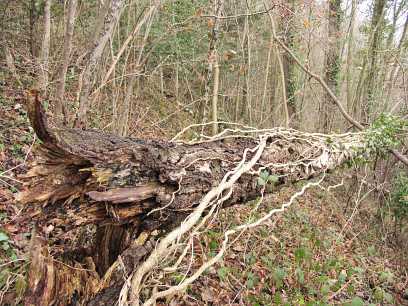 Common sight of Birch ( Betula pendula ) keeled over from the ravages of fungal butt rot and bacterial invasion Note the supple vines which grow on regardless of the Birch's demise. |
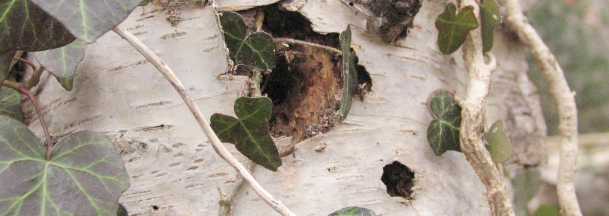 Birds which feed on Insects and Grubs soon invade through the peeling bark. |
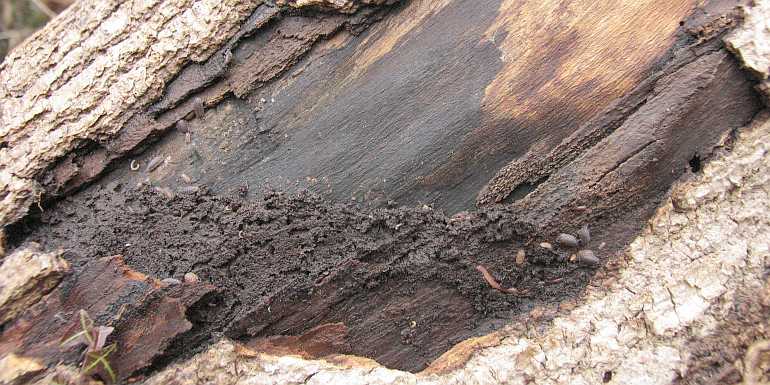 This close up of the outer trunk of the dead Ash tree with bark fallen off shows the rapid establishment of wood lice, millipedes earth worms, and the compost they generate is at this stage almost bereft of easily recognisable microscopic life save for bacteria and what appears to be a variety of spores. |
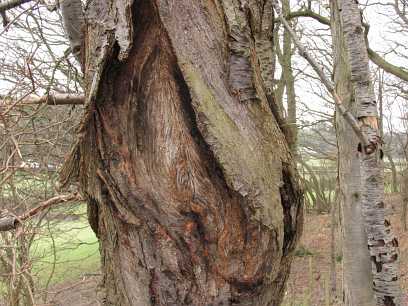 Common Cherry/Gean (Prunus avium) with barks split asunder from years of repetitive insect attack . The surface of the exposed outer sapwood is riddled with grub borers in this example. Note bird made grub feeding holes in a young dead cherry on the right. |
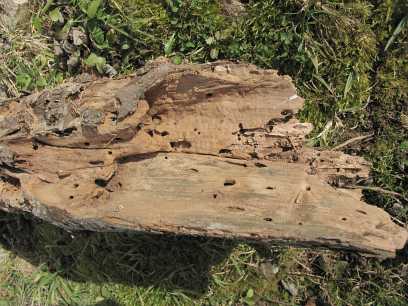 Broken Hawthorn bough after many years of lying in partial contact with soil. Note the discolouration from fungal attack and the prominent exit holes from long horn beetles. |
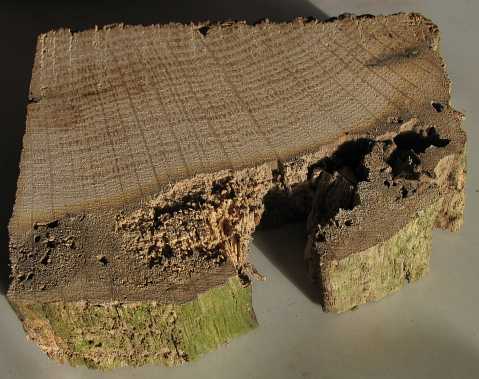 Section of Oak gate frame probably exposed for around fifty years in the open. Note the barely unaffected heart wood clearly showing both annual rings and medullary rays contrasting with the rotting sap wood. Just this 3" x 2" section alone shows about 60 years growth ! |
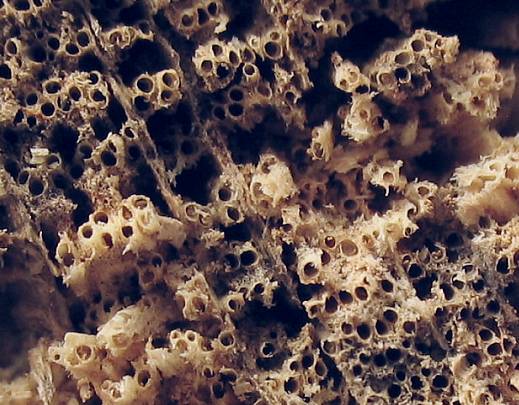 Transport vessels in the sapwood show very clearly the absence of starchy material fed upon by fungal hypha, bacteria and grubworms too. Note the medullary rays. |
Closer look at the vessels which are devoid of starchy material consumed by both fungus bacteria and insect grub worms. Note the waste deposits from the grub worms. |
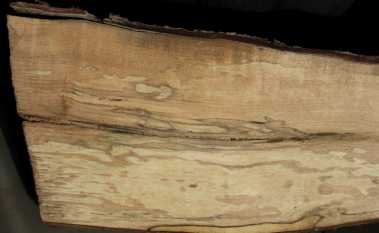 Sections of many varieties of timber like this one which have been left on the forest floor develop interesting stain coloured patterns from fungal and bacterial infestation. The patterns can be extremely attractive and our favoured in certain furniture styles. |
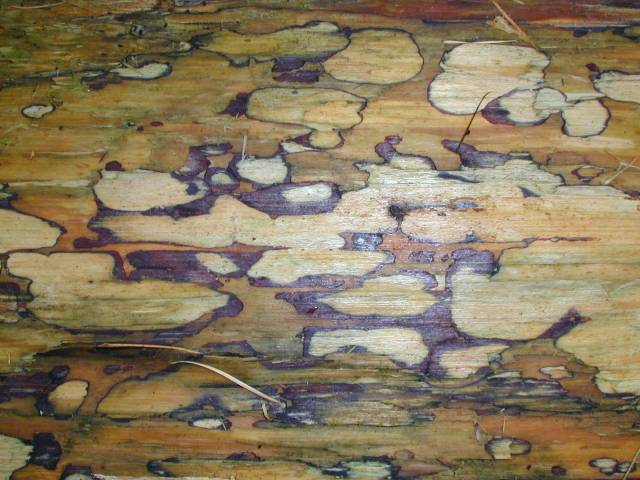 Closeup of a wind blown Larch's ( Larix decidua ) exposed sapwood immediately beneath the bark revealing 'ink stain' fungal development. |
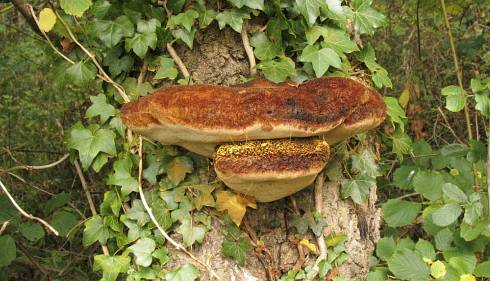 |
| Tell tale fungal fruit body emerging
from tree trunk indicates lengthy invasion probably
starting as far back as 10 years, depending on intrinsic resistance of wood .Fungi often associated with specific trees. In this example of Birch ( Betulas pendula ) the fungus will soon destroy the tree. |
These examples of 'wood wrecking' agents shown above are but a tiny fraction of the enormous variety that exist in woodlands in temperate climates around the globe. When we consider the magnitude of the problem trees face trying to grow normally throughout their relatively extensive lifespans, it becomes apparent that in the end every tree will become the victim to total decay of one form or another. Their leaves right down to the root hairs will at some time be subject to the complex decaying process. Whether this happens early on or later, simply depends on a number of crucial factors. Normally most invaders are resisted by healthy bark, which of course is dependent on the tree being sited on suitable ground with sufficient water and light maintaining the tree's health. However, physical damage from broken limbs soon allows invasive spores to develop their hypae which ingress into the main trunk causing its eventual destruction. Some fungi, notably the Honey fungus attack from beneath the soil's surface through the tree's root system, whilst various insects such as moths can lay eggs on the leaves which if in very large numbers can defoliate the whole tree, and even a whole wood if it is a pure stand..ie Oak.
So in a nutshell the 'Tree wreckers' are constantly threatening their hosts on all fronts and at all times. The peaceful woodland scene often deceives our senses because beneath the outer calm and tranquility there is a war going on that ultimately brings about the death of trees. They all succumb eventually, though Oak and Yew for instance can last for many hundreds of years simply because their heartwood is intrinsically resistant to attack. The giant redwoods of California are amongst the largest forms of life on earth and much older again, though some stunted pines of the desert appear to be the oldest form of life at around 3-4000 years. Clearly moisture level plays a pivotal role here for the tree wreckers, and whilst the UK's woodlands are teeming with their activities, the tropical rainforests of the world must be the most hazardous tree environment of all? No wonder then that in these forests/jungles the timber of many trees have evolved to become very resistant to decay, but then the wood destroyers of the tropics have evolved up a notch too ? The termite has it appears raised its capacity of wood destruction to a much higher level than their counterparts found in the cooler temperate climes. No doubt climate change will bring about alterations in the way our forests and woodlands function, simply because of the variations in water levels there will influence the lifecycles of the wood wreckers, and in so doing have a very significant effect on the life span of trees. Time will surely tell.
| All comments welcome by the author Paul James |
Microscopy UK Front Page
Micscape
Magazine
Article
Library
Please report any Web problems or offer general comments to the Micscape Editor.
Micscape is the on-line monthly
magazine of the Microscopy UK web
site at
Microscopy-UK